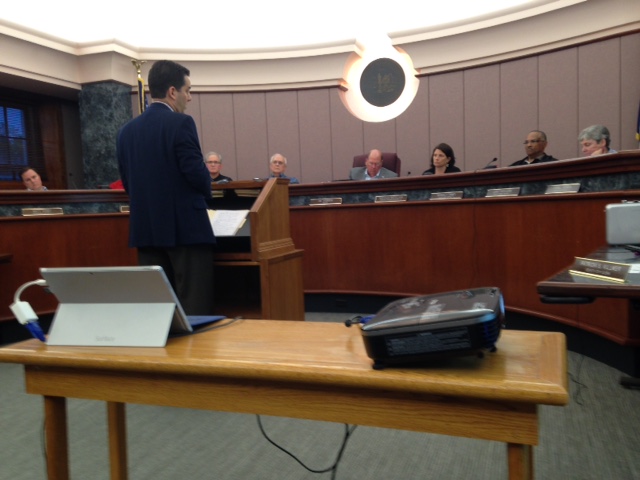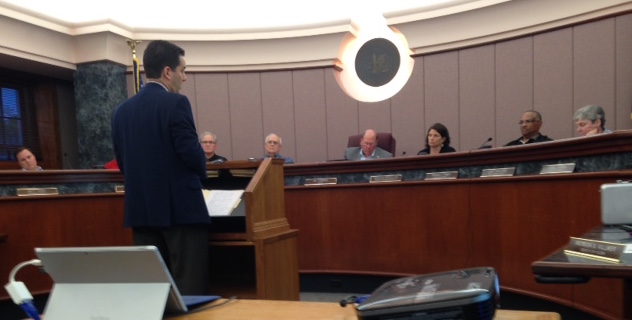In a hearing at the Richmond Heights City Council meeting on Monday, the council heard details of a proposed tax relief plan for the developer of Boland Place, a mixed-use development at Dale Avenue and Boland Place.
Richmond Heights City Manager and the developer, Joseph Cyr, called the tax relief a PILOT (payment in lieu of taxes). Under the proposed plan, which the city council has yet to vote on, the annual property taxes on the completed project would be capped at $297,000 for ten years. It’s estimated that the plan would save Cyr $100,000 over the 10 years, paying about 72 percent of what the tax would be otherwise. If, in an an assessment, the taxes go under the $279,000 cap, the lower tax would be owed.
Cyr said he is forced to ask for tax relief because the projected tax on the completed project came in at 50 percent higher than he expected. He said there was “no rhyme or reason” to the assessment, and his lender told him to figure out the problem.

Nelson Mitten, representing the Maplewood Richmond Heights School Board, said the board supports the plan, considering the increase in taxes. The property could add more than $200,000 to the MRH School District ($236,000). The city will see $22,500. The total tax bill for the property in 2016 was $11,000.
Three residents spoke against the plan: Michelle Bolden and Derek Bolden, who live across the street from the project, and Paul Lore, a former Richmond Heights council member.
Michelle Bolden asked why Cyr is asking for tax relief now, and when it was approved, he didn’t need it? She said the property looks worse now than it did before demolition began, with broken windows in the former school building and more, and that the proposed 24-month construction period is too long.
Lore said he calls the tax relief ‘tax abatement’, not a PILOT — “A rose by any other name… tax abatement by any other name…” He accused Cyr of bait and switch by asking for tax relief now, or that his margin is so thin that if not enough renters come he will default on his loan. He wondered how much difference $100,000 could make on a $34 million project.
Resident, Jeff Saeger said he was in favor of the plan. He said he had received tax abatement on a building he bought downtown, and said, “thank god,” otherwise he and his wife might not be in their home now. He said the 10 years of the abatement will go by quickly.
Ed Notter was the only council member who expressed an opinion — opposing the development. “I find myself in the odd position of tending to agree with ex-councilman Lore,” he said, expressing skepticism about why Cry is asking for tax relief now, and not when it was approved by the council.


I agree with the Bolden’s, I live near this building and its now embarrassing to drive past it. It looks like a dilapidated crack house with broken windows and spray paint. They’ve done a bang up job of ensuring the grounds were secure. Not to mention there has been close to a month since I’ve seen anyone doing anything of use there. Minus some random beat up truck salvaging whatever they can get inside, guessing copper and metal.
I am so disappointed about the whole thing. Everyone knows that developers often change their tune. They always want tax abatement. The need for more apartments is ridiculous because our neighboring cities already have them. Where are all the people coming from? It’s like placing the Menards across the street from Home Depot and down the road from Lowe’s. Who’s doing all this shopping? What I really wonder about is if they can afford to do the underground parking. If not, it will be total chaos. If the developer can’t get it together go back to a plan to build condos.
PILOT. That’s just great. Buckle up, here we go………
Here we go again –another shady developer with a questionable project trying to shake down the local politicos for some gov’t handout…. Seems nothing can ever be built in the free market anymore without gov’t assistance. Thank you Obama – your legacy lives on!
Gov’t handouts have been around for years, pre-dating the Obama administration.
If the project costs are $34 million the total annual real estate tax is likely well north of $500,000 per year. How is the $100,000 developer savings over 10 years calculated?
Comments are closed.